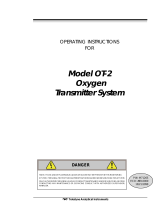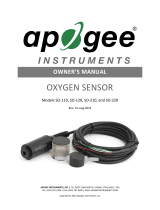
Humidity Changes
The graph below shows an example of humidity dependency.
The sensor chemistry is not inuenced by humidity, but its
output decreases because O2 is displaced by water vapor
molecules in the air. The effect of humidity is larger at warmer
temperatures because there is more water vapor in the air.
Owners Manual
Model: O2M
-D or -F
Oxygen Meter
This sensor is a galvanic cell type oxygen sensor that
measures oxygen gas (O2) in air. It has a lead anode, a gold
cathode, an acid electrolyte, and a Teon membrane. The
current ow between the electrodes is proportional to the
oxygen concentration being measured. An internal bridge
resistor is used to provide a mV output. Unlike polargraphic
oxygen sensors, they do not require a power supply. The
hand-held meter used to measure the sensor uses a standard
9 V battery.
The mV output responds to the partial pressure of oxygen in
air. The standard units for partial pressure are kPa. However,
gas sensors that respond to partial pressure are typically
calibrated to read out in mole fraction of the gas in air, or units
of moles of oxygen per mole of air. These units can be directly
converted to % O2 in air, or ppm O2 in air. The concentration
of oxygen in our atmosphere is 20.9476 %, and this precise
percentage has not changed for decades. It is also constant
across changing temperatures or pressures. This allows for
precise calibration of the instrument.
For use in high humidity, such as in
soil, remove the head and take the
calibration measurement over water
in a sealed container as shown at
right.
Oxygen
Meter
model O2M-F
A ow-through or diffusion head is not required for taking
measurements; heads remove by twisting. In this setup, the
oxygen sensor has been connected to a petri dish to monitor
germinating kernels of corn.

Using the Meter
For the most stable reading, the
sensor should be used with the sensor
opening facing down. This facilitates
the best contact of the electrolyte with
the O2 sensing elements.
Effects on Output
Inuence From Various Gases
The sensor is unaffected by CO, H2, and various acidic gases
such as CO2, H2S, NOX, SOX. However, the Teon membrane
used in the sensor may be damaged by ozone.
Temperature Sensitivity
By itself, the uncorrected mV output of the galvanic cell would
follow changes of the absolute temperature. A 3 °C change
at room temperature (about 25 °C), would change the output
by approximately 1 %.
Pressure Changes
A change in barometric pressure changes the amount of
oxygen available to the sensor and therefore changes what
mV output correlates to oxygen’s atmospheric constant
of 20.95 %. To eliminate this possible error, simply re-
calibrate.
Zero Offset
The mV output in ultra-pure nitrogen gas (0.000 % oxygen)
is typically ± 0.05%. Precise measurements of hypoxic and
anaerobic conditions can be made by making a periodic zero
calibration of the sensor with ultra-pure nitrogen gas. The
zero offset for each sensor is highly reproducible and should
be entered into the programming after a zero- test.
Life Expectancy
The life expectancy of the sensor is expressed in %-hours as
follows:
[Oxygen Concentration (%) x Exposure Time (hours)]
Accordingly, the life of the Apogee Oxygen Meter is 900,000 %-
hours or approximately 5 years of continuous use at 21% oxygen
at 20 ˚C.
Storage Temperature
The life of the sensor can be extended by storage at a lower
temperature. For example a sensor stored at 0 ˚C will have a life
expectancy approximately twice that of a sensor stored at 20 ˚C.
The absolute minimum storage temperature is -20 ˚C. Below that
temperature the electrolyte will freeze. Maximum storage temperature
is 60 ˚C.
Shock And Vibration
The sensor is resistant to 2.7 G of shock. However, vibration may
inuence the sensitivity of the sensor and should be minimized.
1. To use the instrument, turn the
dial to the “ON” position.
2. To calibrate, place the sensor in
a well ventilated area and use
a small screw driver to turn the
potentiometer until the meter
reads “100”. This represents 100
% of the atmospheric constant
20.95 %.
5. Recalibrate as needed when
changes in pressure, temperature,
or humidity occur.
Location of the
potentiometer
for calibrating
the instrument
Specications
435-792-4700
www.apogeeinstruments.com
Sensor head dimensions Diffusion Head (D) Flow Through (F)
1.375” tall,
1.375” dia.,
125 mesh screen
creates air pocket
3.5 long by 3.5 cm dia.
1/8” Barbed adapters
for hose connections
Sensor dimensions 3.15 dia. by 6.85 cm long. 1/2” X 20 threaded end
Mass 290 g
Range 0 to 100% O2
Accuracy < 0.01% O2 drift per day
Repeatability ±0.001% O2 (10 ppm)
Input power Standard 9 V battery
Operating environment 0 to 50 °C. Less than 90% non-condensing relative
humidity up to 30 °C. Less than 70% RH from 30
to 50 °C
Cable 2 meters of shielded, twisted pair cable wire with
Santoprene casing. Extra cable 2.95/meter
Warranty 1 year parts and labor
-
 1
1
-
 2
2
apogee INSTRUMENTS O2M-F Owner's manual
- Type
- Owner's manual
- This manual is also suitable for
Ask a question and I''ll find the answer in the document
Finding information in a document is now easier with AI
Related papers
Other documents
-
Apogee SO-421 User manual
-
Apogee SO-220 User manual
-
Apogee SO-110 Owner's manual
-
Apogee MO-200 Owner's manual
-
GREISINGER GMH 3651 Operating instructions
-
GHM GMH 5650 Owner's manual
-
GHM GMH 3651 Owner's manual
-
Rosemount 1181-SO Dissolved Oxygen Transmitter Owner's manual
-
Rosemount PB Series Owner's manual
-
 Teledyne OT-2 User manual
Teledyne OT-2 User manual





